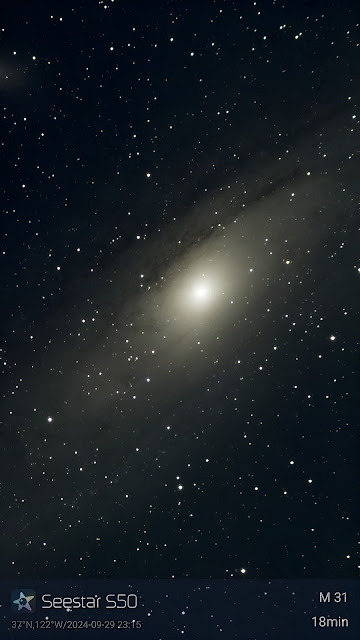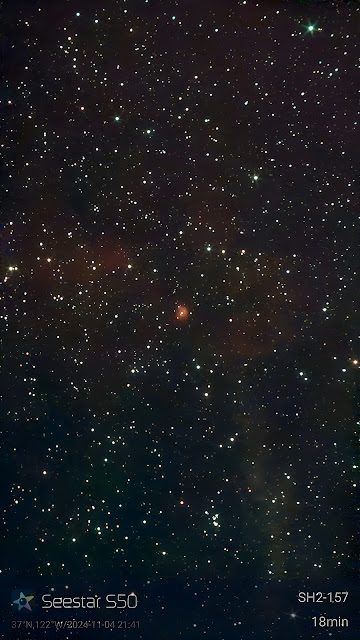DSO
All photographs shot on the Seestar S50, in light polluted, suburban backyard skies
Photos edited with noise reduction & image enhancement software
_____
Orion Nebula
Planetary / diffuse nebula, located just south of Orion's Belt. At a distance of approx 1500 ly and about 25 ly across, this is one of the closest areas of active star formation.
____
Horsehead Nebula
Dark nebula in the constellation of Orion, in close proximity to the bright star Alnitak in the Orion's Belt
____
Flame nebula to the left of Alnitak, Horsehead nebula below. Alnilam, the second of the three stars of Orion's Belt shines at the top right.
____
Rigel
Blue supergiant in Orion, at a distance of 860 ly
____
Betelgeuse
Red supergiant in Orion, around 500 ly away
____
Flaming Star Nebula
Emission nebula in the constellation of Auriga
____
Pleiades
The Seven Sisters are part of an open cluster of more than 250 stars 444 ly away
____
Andromeda Galaxy
Also known as M31, this is the nearest galaxy to the Milky Way, at a distance of 2.5 million ly
_____
Pacman Nebula
Located in the Perseus spiral arm of the Milky Way and found in the constellation of Cassiopeia, this emission nebula is at a distance of 9200 ly
_____
Triangulum Galaxy
M33 is located 2.73 million ly away, and is the third largest member of the local group of galaxies, behind Andromeda and the Milky Way.
_____
M15 Pegasus Cluster
This globular cluster in the Pegasus constellation is estimated to be over 12.5 billion ly away.
______
M103 Open Cluster
An open cluster in the constellation of Cassiopeia, this is at a distance of 8000 to 9500 ly
_____
Deer Lick Group / Caldwell 30
A spiral galaxy in the constellation of Pegasus, located 40 million ly away
______
Phantom Galaxy
A large spiral galaxy in the constellation of Pisces, this is 32 million ly away and estimated to be home to 100 billion stars.
_____
Pleiades Open Cluster
The seven sisters, located close to the constellation of Taurus form an asterism and are part of an open cluster located 444 ly away, and the closest Messier object from earth.
_____
Fossil Footprint Nebula
Located in the Perseus constellation
_____
Heart Nebula
Emission nebula located in the Perseus spiral arm of the Milky Way, and found in the constellation of Cassiopeia, at a distance of 7500 ly
_____
North American Nebula
Veil Nebula
Found in the constellation of Cygnus
_____
Scorpion Cluster
Open cluster in the constellation of Cassiopeia
_____
M39 Open Cluster
Lobster Claw Nebula
_____
Spiral Cluster
Large open cluster in Perseus
_____
Barbell Nebula
Planetary nebula in the constellation of Perseus, at a distance of 2500 ly with neutron star or white dwarf remnants
_____
Pelican Nebula
Emission nebula in the constellation of Cygnus, located close to Deneb and the North American Nebula
_____
Whirlpool Galaxy
Spiral galaxy 31 million ly away
_____
West Veil Nebula
Cloud of ionized gas and dust, located in the constellation of Cygnus
_____
Eye of God / Eye of Sauron
Aka Helix Nebula, found in the constellation of Aquarius - and at 650 ly away, this is one of closest planetary nebula to earth
_____
Hercules Cluster
Globular cluster in the constellation of Hercules
_____
Crescent Nebula
Emission nebula in the constellation of Cygnus, 5000 ly away, formed by the transformation of a Wolf Rayet star into a red giant, 250-400,000 years ago
_____
Bubble Nebula
Located in the constellation of Cassiopeia, the bubble is a result of stellar wind from a hot, young star in the center of the emission nebula
_____
Wizard's Hat Nebula
_____
Firework Galaxy
At a distance of 25 million ly, and found along the constellations Cygnus and Cepheus, this is located in the Virgo Supercluster (but outside the Local Group that contains the Milky Way, Andromeda and Triangulum Galaxies).
_____
Iris Nebula




































Comments
Post a Comment